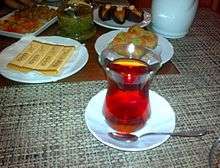Azerbaijani tea culture

Tea in Azerbaijan is served freshly brewed, hot and strong. It typically has a bright colour and is served in crystal or any other glasses or cups. Azerbaijanis often use traditional armudu (pear-shaped) glass. Tea is served continuously when there are guests or when there is an interesting conversation. For Azerbaijanis tea with milk is uncommon. According to a common belief, drinking tea with lump sugar instead of sand sugar comes from the medieval period, when rulers who were afraid of being poisoned checked their tea by dunking a piece of sugar in a beverage – it was believed that the poison would react to the sugar).[1] Traditional tea is served with lemon, cube sugar, sweets and fruit desserts (not jam).[2] Sometimes thyme, mint or rose water is added, which is believed to be good for the stomach and heart.[1]

Azerbaijani people may drink tea in traditional tea houses called chaykhana. Men sit in a chaykhana, playing backgammon (nard), reading newspapers and drinking tea.[3] Historically, Azeri women did not go to public places, so chaykhana used to be a place for men.[4]
For Azerbaijanis tea is associated with warmth, hospitality[2] tradition says that one should not allow the guest to leave the house without at least one cup of tea.
Tea in Azerbaijan is also served during matchmaking. After the negotiations by matchmakers are complete, the maid will bring out tea. If the tea is served without sugar, that is a sign that the chances for marriage agreement are very low; conversely, if tea is served with sugar, it means that there will be a wedding.[1]
Azerbaijanis say about tea “Çay nədir, say nədir” which can be translated as “when you drink tea, the cup count doesn't matter” and means that tea is something almost “sacred” in Azerbaijan.
History
Historically, tea production used to be one of main industries in Azerbaijan. Although the first tea bushes were grown in Azerbaijan in 1912, tea-growing gained commercial value in the 1930s. In 1934, specialists from Moscow visited Lankaran and took samples of the soil. They analyzed the samples and found that Lankaran is one of the most fructuous areas for tea growing. Since that time, tea factories have been operating in Lankaran and neighbouring regions. From then on, Lankaran became the main area in Azerbaijan for the cultivation of rice, tea, citrus fruit and vegetables.
In the 1980s, tea-production peaked up in Soviet Azerbaijan. Approximately, 34-38,000 tonnes of tea leaves were harvested annually in that time. However, tea production decreased as a result of the fall of the former Soviet Union. In 2007-2008, less than 500 tonnes were harvested and it was the lowest point.[5]
Tea drinking traditions
In Azerbaijan, people drink tea from the special glass called “armudu” (literally pear-like glass). The shape of Armudu glass is similar to a pear and is associated with the figure of a hostess in Azerbaijani culture. It is believed that the classic shape of Armudu represents the ideal figure of an Eastern woman or an 18 year old Azerbaijani girl. Tea is served with various delicious sweeties, fruit jam and sliced lemon.[6]
Samovar tea
In Azerbaijan, people boil water in heated metal containers known as samovars. Archeologist Tufan Akhundov, found the a pottery-shaped -oldest samovar,possibly up to 3,600 years old, in Sheki a town located at the foothills of the Caucasus.
References
- 1 2 3 "Chaihana: culture in action". Aze.info. Retrieved 14 December 2012.
- 1 2 Africa, Asia, and Oceania: Culturegrams 2002. Page 19
Visiting relatives or friends is popular, and hospitality is part of the culture. Friends and family visit without prior notice. Guests often are invited for a meal or for tea. Tea is a friendly midafternoon affair that includes pastries, fruit deserts, fruit, candy and tea:
- ↑ Azerbaijan. David C. King
- ↑ The Azerbaijani Turks: power and identity under Russian rule. Audrey L. Altstadt
- ↑ "Visions of Azerbaijan Magazine ::: God's Drink - Voyage to the land of Azerbaijani tea". Visions of Azerbaijan Magazine (in Russian). Retrieved 2017-05-20.
- ↑ "Ancient traditions of tea drinking in Azerbaijan". AzerNews.az. 2013-04-26. Retrieved 2017-05-20.